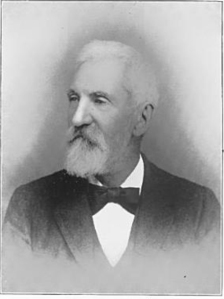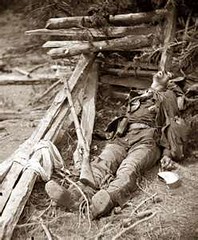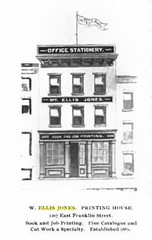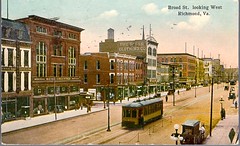The following is a faithful transcription of a photocopied newspaper page, one of many documents I received from D. L. Bond, of Raleigh, N.C., as part of a collection of memoirs and papers, as well as genealogical information related to Lewis Evan Jones Jr. (1825 – 1910), his antecedents and descendants, and the “Nebraska line” of the Jones family, originally of Dolgelly (Dolgellau), Wales and Carnarvon, Wales. Mr. Bond is a great-great-grandson of Lewis Evan Jones Jr. I have no information what newspaper this article originally appeared in, or the date of publication. If anyone can help me identify this article’s origin and date, please contact me.
B. Paul Chicoine, the “Journal correspondent” who authored this piece, is apparently the same person of that name who co-authored the book Sioux City – A Pictorial History, the Donning Company, 1982. He appears to have also authored or co-authored a number of other historical articles and text books.
“Sagging landmark survives at Wynot

Historic mill – The historic three-story Bow Valley Mill still stands near Wynot, Neb., although sagging underpinnings cause it to teeter toward the spillway dug more than 100 years ago. The addition at the right is used to store farm machinery. (Photo by B. Paul Chicoine, Journal correspondent) (Photo shown above is not original to the article. It was taken by an unidentified photographer at a later period.)
By B. Paul Chicoine
Journal correspondent
WYNOT, Neb. – Time and grazing cattle may be kicking the underpinnings from a massive three-story frame structure near Bow Creek, but the Bow Valley Mill is a persistent survivor.
Perched on the bank of a dried up millpond, Cedar County’s oldest surviving landmark hangs on to the future with slipping fingers – a sad state of affairs for a building which has survived time, technology, floods and efforts by one of Cedar County’s more colorful and industrious families to keep the ancient giant in production.
Situated a quarter mile south of bubbling Bow Creek, a major water course in the north Cedar County area, the Bow Valley Mill is a monument to this family and to the raw, untamed wilderness of the Nebraska frontier. It was founded by Lewis Evan Jones and is part of an industry bloodline which included the Christian Advocate.
In 1857, while Jones, founder of the Advocate, was still plying his trade and papers, he was intrigued by a company of town promoters involved in establishing a prairie city along the Missouri River in Nebraska Territory.
Family accounts and local records show Jones, a native of Carnarvon, Wales, was impressed by the immense acreages of hardwoods which lined the hills in this region and the available water power along its creeks.
Turning publication of his newspaper over to a colleague in St. Louis, he embarked upon a milling career which was to develop the huge mill at Bow Valley.
Mrs. John (Edith) Jones, grand daughter of the mill’s founder, maintains a careful collection of its records. She says the family business survived 100 years of prosperity and disaster by adapting to changing times and needs of Cedar County.
Those needs included making flour for the gold prospectors of Montana and later, generating electricity.
The mill is said to have helped supply the soldiers in the last campaigns against the Indians.
“There must have been thousands of tons of wheat through those old stone burrs,” says Mrs. Jones, a spry and effervescent woman in her 70’s. “A good share of it went to the government for outposts and reservations too.”
Riverboats upbound from Sioux City to Montana stopped regularly to take on fuel and freshly milled flour at the mill’s private landing, located a short distance north on the Missouri River.
Along with processing locally grown wheat and corn, a sawmill attached to the mill’s east side supplied planks, timbers, and framing for homes and farms in Wynot, St. James, nearby St. Helena and Yankton.
With the coming of the railroad and the founding of Wynot, the track’s terminus in 1907, the mill’s creeking side-shot water wheel was harnessed to an electric generator to power the town’s first electric lights.
Built of local hardwoods – maple, oak, and walnut – and mortised and tenoned throughout, Bow Valley Mills shows the work of skilled hands. Its records show the persistence of the Jones family in keeping it alive through three generations.
Wheat, hauled in by pack horse and wagon, was ground on the first floor by water-powered burrs, then sacked and stored in a “mouse-proof” flour house alongside.
Mouse-proofing was accomplished by overlaying walls with tin. The materials were shipped upriver by steamboat.
Water-powered elevators raised wheat to the two top floors for temporary storage.
A quarter-mile millrace delivered water from a rock and log dam across Bow Creek to the south. Later, after floods destroyed the first dam, Thomas Jones, son of the founder, constructed another dam of railroad iron and concrete further west. Mr. Jones recounts that the sheer weight of the second dam caused it to sink beneath the river bank, thus closing the mill for good.
Milling thus ended at the at the ancient landmark in the 1920’s. Subsequent attempts to revitalize the structure failed, ending in the mill’s conversion to Commodity Credit Corp. grain storage in 1939.
Today the giant wood structure stands in silence a dusty gravel road. The sawmill and mouse-proof flourhouse are gone. So is the great creaking waterwheel, and the shafts of machinery it turned. Spilled aots and assorted rubble litter the mill’s huge interior. Below and away a herd of black cattle graze quietly amid willows where head deep mill waters used to rush.
Like most of the Wynot community, Cedar County has voiced no plans to restore the venerable structure which now sags precariously toward the spillway its founders dug.
A local landmark, a Nebraska industrial relic, or just a memory, the Bow Valley Mill stands waiting for another stream of genius to harness its silent wheels.”












You must be logged in to post a comment.